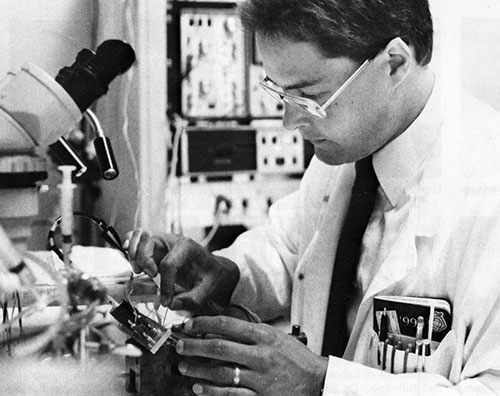-
Featured News
#FlashbackFriday 1990: New Mayo Associate

This article first appeared in July 1990 in the publication Mayovox.
Dissecting a disease’s effects keeps James D. Schmelzer’s research work interesting and challenging from day to day.
As supervisor of the Neurophysiology Lab and Autonomic Reflex Lab, Schmelzer participates in research on peripheral nerves, specifically nerve blood flow and oxygen delivery within the nerve. The research focuses on diabetes and how it can damage peripheral nerves outside the central nervous system.
Schmelzer has a keen interest in probing the effects of diabetes and seeking information that could benefit people with diabetes.
“Most of our research relates to diabetes and its effects,” he says. “We want to understand what diabetes is doing to the peripheral nervous system – then try to decide what we can do to reverse some of the abnormalities it causes. Hopefully, what we learn will one day help diabetic patients.”
Since Schmelzer came to Mayo in 1979, he has been the lead technician in Dr. Phillip Low’s Neurophysiology lab. His technical skills and research efforts are among the reasons he was selected as the 33rd Mayo Clinic paramedical staff member to receive Associate status. The Associate distinction recognizes paramedical employees for their contributions to medical practice, education and research.
In nominating Schmelzer for Associate status, Dr. Low noted Schmelzer’s growing technical and administrative skills and his progressive development as an investigator.
“Jim has been a key figure in the developmental aspects of my research program,” Dr. Low says. “His level of expertise is that of a postdoctoral fellow and, in some areas, is superior to that of a postdoctoral fellow.”
A graduate of St. John’s University in Collegeville, Minnesota, Schmelzer’s research activities include in vivo and in vitro electrophysiologic studies, and isotopic evaluation of the blood-nerve barrier.
Schmelzer has 25 publication credits, including three as first author published in scientific journals. He also plays a key role in instructing new research fellows, visiting scientists and other technicians, according to Dr. Low. In addition, he designs experiments and analyzes data gathered in research.
Dr. Anthony J. Windebank, chairman of the Neurology Research Committee, says “He can lead and organize efficiently while always being pleasant and a pleasure to work with. He has the ability to suggest the best designs for experiments.” Schmelzer notes that he’s part of a team effort.
“I get involved in electrophysiology. If we want a biochemistry evaluation, we have someone whose forte is biochemistry. We also do nerve blood-flow measurements, and we have a visiting physician who does most of those measurements,” Schmelzer says. “We have a lot of components for experiments to make a well-rounded study.
“Our research is fascinating because we’re trying to identify a problem and hopefully, remedy or at least reverse some of the abnormalities a disease like diabetes can cause.”







